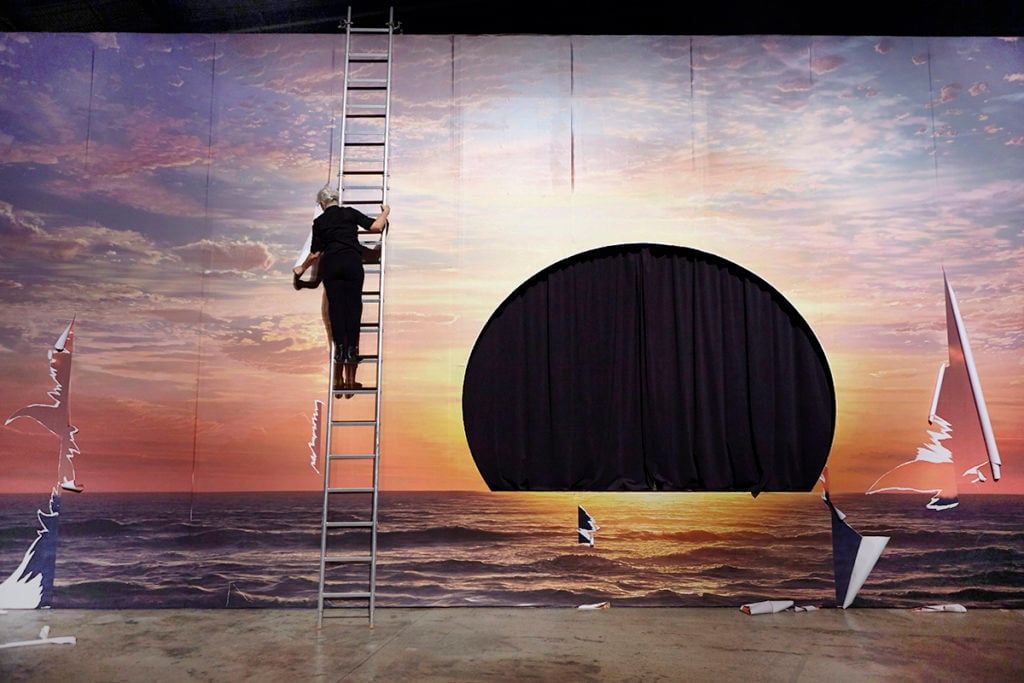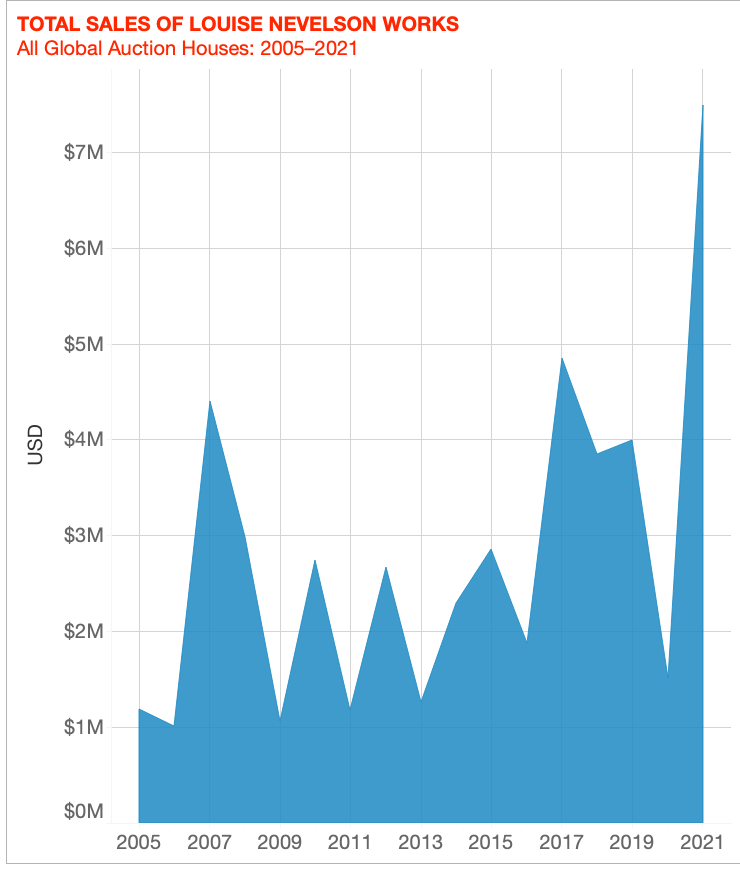The Back Room
The Back Room: Chart the Biennial Stars
This week: Biennial World vs. Art Market World, dealers battle for primacy in New York and L.A., Louise Nevelson gets her due, and much more.

This week: Biennial World vs. Art Market World, dealers battle for primacy in New York and L.A., Louise Nevelson gets her due, and much more.

Julia Halperin &
Naomi Rea

Every Friday, Artnet News Pro members get exclusive access to the Back Room, our lively recap funneling only the week’s must-know intel into a nimble read you’ll actually enjoy.
This week in the Back Room: Biennial World vs. Art Market World, dealers battle for primacy in New York and L.A., Louise Nevelson gets her due, and much more—all in a 7-minute read (1,595 words).
________________________________________________________________________________________

Neha Choksi, The Sun’s Rehearsal /In Memory of the Last Sunset (2016). Commissioned by the 20th Biennale of Sydney. Courtesy the artist and Project 88, Mumbai. Photo: Zan Wimberley
If you could somehow see every biennial or triennial in the last five years, what patterns would emerge? Which stars would shine brightest?
These are the questions behind the Biennial Artist Project, a series from Artnet News on the stars of the biennial circuit. We examined the artist lists for 211 biennials and triennials held over the past five years to find out which artists are the most widely exhibited.
The research revealed not only a surprising cast of leading figures, but also several key distinctions between what our art critic Ben Davis dubbed Biennial World and Art Market World. Here’s what we found.
Biennial stars don’t at all correlate with art-market power rankings. There is almost no overlap between the under-40 stars who have emerged from the recent epoch of biennials—such as multimedia artist Korakrit Arunanondchai, video artist Uriel Orlow, and sound artist Lawrence Abu Hamdan—and those of the same generation who have become art-market darlings over the last five years (think: Amoako Boafo, Ivy Haldeman, Anna Weyant).
A total of 1,599 artists have appeared in more than one of these big survey shows since the last Documenta in 2017. The majority come from outside of typical market centers, with a strong representation of diasporas stemming from Asia, the Middle East, and Latin America. Look closer, however, and a more traditional concentration of geographical power persists: Mapping out the places where the 75 top artists keep their studios, a little more than half work in Berlin, London, or New York.
Most of the mega-galleries are entirely absent from the list of dealers who represent the top 30 biennial artists. The leaders are Mor Charpentier (which reps four of the top 30), König Galerie (three), and Tanya Bonakdar (three). Many of these dealers consider promoting biennial stars as its own kind of calling—but it’s not lucrative, especially at the start. “Money has never interested me really,” dealer Andrée Sfeir-Semler said. “We need it, but it is not our aim.”
There is a widespread assumption that inclusion in biennials will lead to sales for artists down the line. But the gulf between the mainstream art market and the biennial world shows that this assumption is deeply flawed. (Paris dealer Imane Fares even transfers money from her construction business to keep her biennial frequent fliers solvent.)
Certain commonalities among biennial stars help explain this phenomenon. They often focus on complex, critical themes such as climate change, politics, violence, and oppression. And they usually express these ideas through media that are difficult to display, including ambitious installations and multi-channel video works. The problem is that, now more than ever, dealers say, even once-ambitious buyers want painting, painting, and more painting.
For now, then, most biennial artists rely on a patchwork of support that includes government funding, public foundations, and private money, as well as dealers who are playing the long game. But these safety nets are fragile, and should they break, institutionally prized “biennial artists” will be left in the cold.
All this to say, if biennials do not find a way to adequately pay their participants, or scale back in number and size, their proliferation is actually a threat to the production of the work they purport to champion. All that will be left of this generation’s artistic output will be easy-to-digest paintings that make a splash at Art Basel or Christie’s. And that would be a bland future indeed.
________________________________________________________________________________________

The Hirshhorn Museum. (Photo by Yana Paskova/For The Washington Post via Getty Images)
In this week’s Wet Paint, we reveal a new art reality show that will award the winner a solo exhibition at the Hirshhorn Museum, and a Basel social club that wants to give the Three Kings a run for its CHFs.
Here’s what else made a mark around the industry since last Friday morning…
Art Fairs
New York nonprofit The Kitchen will have a stand at the upcoming Armory Show to showcase little-known works from its archive as it embarks on a major renovation. (The Art Newspaper)
Auction Houses
Phillips will host its first live auction in Southampton on June 25, where it has operated an exhibition space since August 2020. The sale includes prints and multiples by Andy Warhol, Catherine Opie, and David Hockney. (Press release)
Galleries
Lots of expansion news: Los Angeles stalwart Nino Mier is expanding to New York with a Soho gallery in January 2023; Sprüth Magers is setting up shop on the city’s Upper East Side this month; and Marian Goodman is expanding to Los Angeles. (Financial Times, Press release, Artnet News)
Xavier Hufkens now reps the estate of Milton Avery (in partnership with Victoria Miro). Hufkens will include Avery’s work in its Art Basel booth next week. (Press release)
Institutions
France’s ministry of culture has suspended ex-Louvre president Jean-Luc Martinez from his role as cultural heritage ambassador while he is under investigation for alleged complicity in organized fraud and money laundering. (Artnet News)
The Philadelphia Museum of Art hired Sasha Suda as its new director and CEO. Suda, who has held the same dual role for the National Gallery of Canada, will join the PMA in September. (Artnet News)
NFTs and More
Pace Verso has teamed up with Art Blocks to release “boundary-pushing generative NFT projects” by artists from the Pace stable as well as crypto native artists. (Press release)
________________________________________________________________________________________
“In the countries we often call eastern Europe and southeast Europe… we have seen a pattern of astonishing, sometimes nearly absurd, cases of primary interference of politics in museum governance, virtually annihilating the capacity of the institutions.”
—Bart de Baere, chair of CIMAM’s Museum Watch program and director of the Museum of Contemporary Art in Antwerp, on the recent history of government meddling in museums. The organization is helping draft a new set of guidelines to help cultural institutions maintain independence. (The Art Newspaper)
________________________________________________________________________________________

© 2022 Artnet Worldwide Corporation.
In the 1970s, Louise Nevelson couldn’t walk down the street without being asked for an autograph. Nearly every show she staged sold out. But after she died in 1988, her market went into hibernation—and only now does it seem to be waking back up. Her auction record currently sits at $1.4 million, a fraction of those of peers like Louise Bourgeois ($32 million) and Barnett Newman ($84.2 million). Here are the factors that contributed to this arrested development.
The upward trend is continuing: three of Nevelson’s works sold for multiples of their estimates during the May auctions in New York.
The takeaway? If you have sticker shock from the price of work by artists who only recently became old enough to rent a car, remember that there are still pockets of the market where there is plenty of room to grow—and plenty of art history to back up the prices.
________________________________________________________________________________________